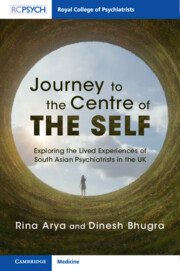 Journey to the Centre of the Self
Journey to the Centre of the Self Book contents
- Journey to the Centre of the Self
- Reviews
- Journey to the Centre of the Self
- Copyright page
- Contents
- Acknowledgements
- Glossary
- Part I Contextual Information
- Introduction
- Chapter 1 Culture and Psychiatry
- Chapter 2 An Overview of South Asian Migration to the UK
- Chapter 3 An Overview of the Interviews
- Chapter 4 Capturing the Lived Experience
- Chapter 5 The Primacy of the Lived Experience as the Route to Change
- Part II The Interviews
- Part III Analysis
- References
- Index
Chapter 5 - The Primacy of the Lived Experience as the Route to Change
from Part I - Contextual Information
Published online by Cambridge University Press: 04 October 2024
- Journey to the Centre of the Self
- Reviews
- Journey to the Centre of the Self
- Copyright page
- Contents
- Acknowledgements
- Glossary
- Part I Contextual Information
- Introduction
- Chapter 1 Culture and Psychiatry
- Chapter 2 An Overview of South Asian Migration to the UK
- Chapter 3 An Overview of the Interviews
- Chapter 4 Capturing the Lived Experience
- Chapter 5 The Primacy of the Lived Experience as the Route to Change
- Part II The Interviews
- Part III Analysis
- References
- Index
Summary
This chapter examines the predicament outlined in the previous chapter, of the non-white body showing up in white spaces. Whilst a staunch objective of postwar black cultural politics, and of this book itself, is to portray the heterogeneity of the cultural identity of non-white ethnic minorities, in reality what happens in the lived experience is that the individual is interpreted through their racial characteristics, chiefly skin colour, which skews a holistic understanding of the person. The ‘historico-racial schema’ devised by Fanon that defines the restrictions faced by the non-white body in space, is explored in more widely and is theorised in Sara Ahmed’s insights in her study of the phenomenology of whiteness where she conveys the precarious situation of non-white bodies inhabiting white spaces. When they fit in, they are rendered invisible, and when they don’t and ‘stand out’ and ‘stand apart’, they are ‘hypervisible’ (2007, 159). Either way, visibility is not permitted in their own terms. In the interviews that followed the psychiatrists did not enjoy white privilege and there were times when they were made to feel different, a theme that was explored within the context of acculturation and other factors.
- Type
- Chapter
- Information
- Journey to the Centre of the SelfExploring the Lived Experiences of South Asian Psychiatrists in the UK, pp. 38 - 46Publisher: Cambridge University PressPrint publication year: 2024
